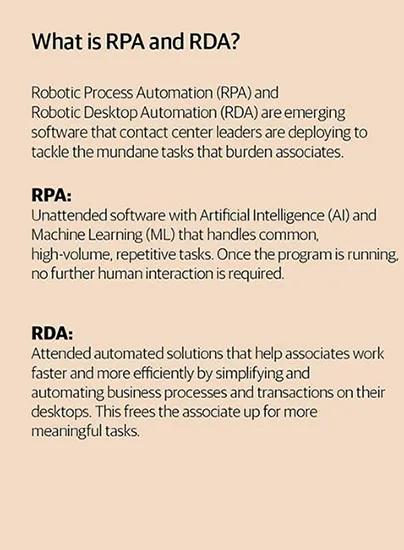Prior to COVID-19 many organizations took their time with their automation approach. It was a nice to have application in a world where voice and face-to-face interactions were the norm. My how things have changed.
Last year, when TTEC interviewed Thom San Filippo, VP of Customer Service and Experience Design at Dow Jones, he said that, “[AI] is the next big thing that’s out there. I think very few people are doing a good job of those right now, but it’s just a matter of time before everybody gets better at it.” It highlighted a time where people understood that automation was needed but didn’t necessarily understand where or how to apply it.
Following these months of intense uncertainty, organizations who fared better were those who used intelligent automation to better assist their employees and agents with self-service and relevant suggestions.
Automation solutions are no longer an option. We need to match the expectations that come with a fast-paced digital landscape. To get there, here are essential robotic automation applications your organization needs to deploy to create effortless employee and customer experiences.
Why intelligent automation matters
RPA and RDA [see chart] are key intelligent automation solutions that reduce the effort of employees to go through information and resolve issues.
Overlooked aspects such as multiple login screens, forms, and call disposition processes are often seen as barrier for employees to get at the heart of a customer’s issue. This was expedited when COVID-19 brought forward a surge of demands for information on testing locations and new rules that could have been regulated to an FAQ.

Employees in all industries worked to their limits to be there for their customers, but the introduction of automated solutions such as chatbots could have helped deflect non-essential calls and freed them up to assist in more meaningful, complex, and emotional interactions.
Successful automation solutions deploy technology to create effortless experiences for employees and customers. When volume surges hit, employees need to have the tools that allow them to hit the floor running.
Applications of Intelligent automation
This is especially relevant in the customer service space, where leaders in all industries should be able to deploy automation to make their employees job easier and more efficient. Here are a few applications of intelligent automation that can be used from the beginning and end of the workday:
Start my day: Automatically trigger all the applications used by an employee at the beginning of their workday to let them start faster.
Customer 360 view: Empower employees with historical information about customers. Is it a repeat call? What were their past interactions? Etc.
Call disposition: Capture selected actions and information during a call to help discover the call reason and emotions to help better understand the interaction.
Single sign-on: Sign into selected applications whenever necessary during the workday. The information needs to only be entered once, thus giving the employee more time to focus on pressing tasks.
Application toolbar: Build in all the shortcuts to allow employees to quickly navigate and perform tasks quickly.
Call wrap-ups: Automate the steps required to introduce into the different systems after a call has ended to free the employee and reduce the transition to the next call.
In a world where customers are bypassing voice to get their answers quickly, agent tools should match their expectations. The best tools simply let employees do their job. Automation solutions can help at every step of the way.
Automate to make life’s biggest step easier
We’ve utilized intelligent automation to bring customers one step closer to a new home. In one instance, a government housing ministry offered a program to sell homes to citizens while providing banking assistance with their loans. However, limited documented processes, difficulty tracking information, various booking systems, and multiple in-person visits created a disconnected experience that made completing the sales difficult. This led to long wait times and cancelations.
Using robotic desktop automation (RDA), we integrated five sales applications onto a single screen for sales agents. Now salespeople could streamline appointment confirmations, house selection, payments, and customer documents uploads all within the same desktop.
These applications allowed the client to easily access the reports and dashboards for visibility across the entire sales funnel, internally and with banking and development partners.
Customers had a simple and convenient process to choose and book a future home, thanks to frequent updates from the client on bookings and banking processes. This reduced the sales process time by 80% and increased units booked by 26%.
Build a more intelligent future
Organizations that continue to invest in automation capabilities are ultimately investing in the tools to make the employee experience more human. The foundation of automation is not to phase out humanity, but to make people better at what they do. Organizations that can deploy the best of humanity with the best of technology will help create better experiences.
Investing in automation intelligently means being a part of the disruption that is destined to be the new normal. Providing employees with the tools to free up their work for meaningful interactions will result in success no matter what the situation.
















